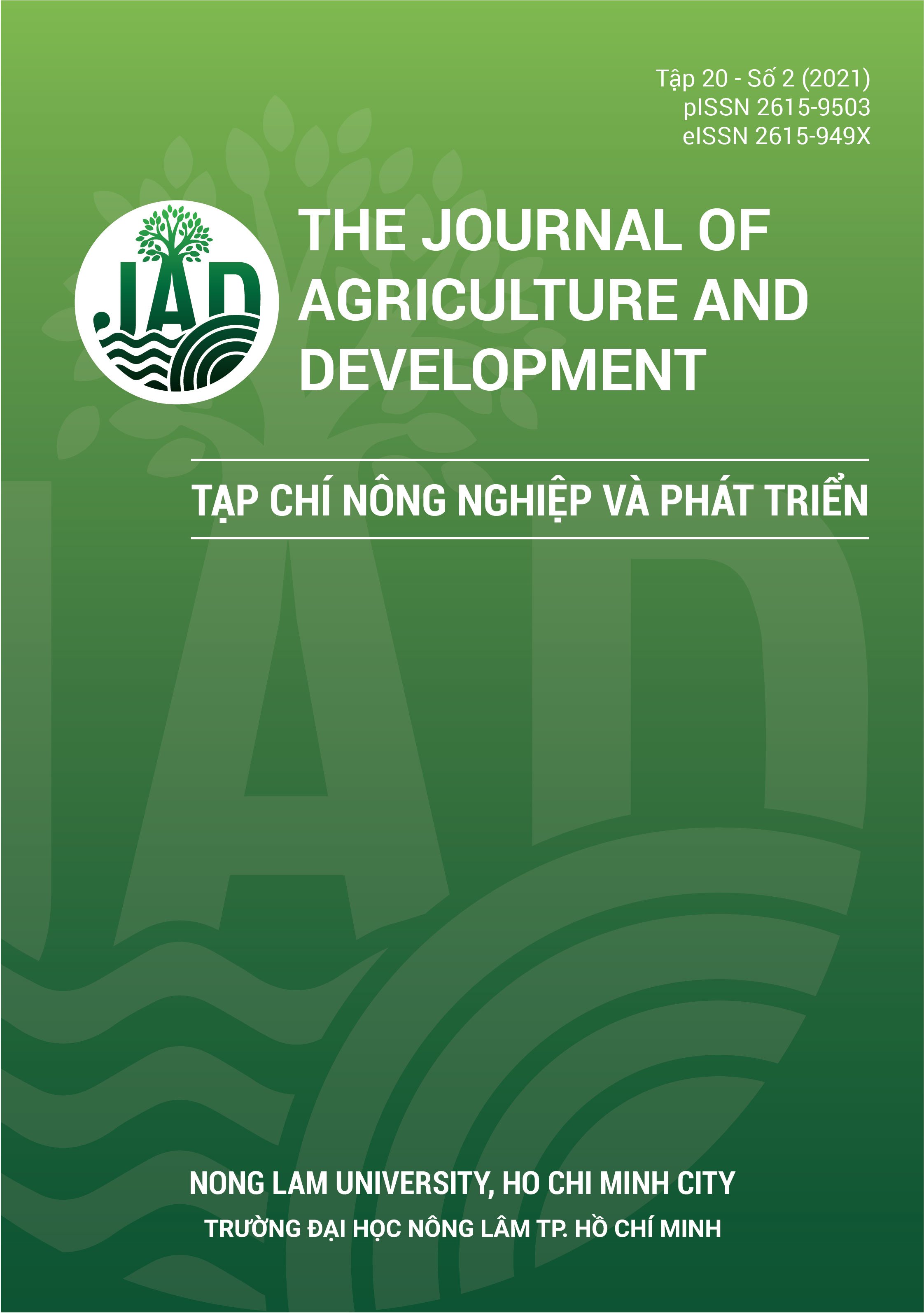Hygienic conditions of the processing environment and microbial loads of Tra fish (Pangasius hypophthalmus): Trimming step
Main Article Content
Abstract
During the processing of frozen Pangasius hypophthalmus fillets, the microbiological counts depend on the source of raw materials and processing conditions, those impact significantly on the quality of the final product. In particular, trimming is considered a high-risk step of cross-contamination during processing. This study aimed to compare and evaluate the microbial quality at trimming step in four frozen Pangasius processing factories located in the Mekong Delta region. Trimmed Pangasius fillet and contact surfaces samples (i.e., gloves and processing tools) were examined including total mesophilic counts, Coliforms, E. coli and coagulase-positive Staphylococci (Staphylococci coa+). The results showed that total mesophilic counts on trimming Pangasius processed in A, B, C and D plant were 7.1 ➧ 0.4; 7.5 ➧ 0.7; 6.7 ➧ 1.1 and 6.0 ➧ 0.4 log CFU/g, respectively. Coliforms, E. coli and Staphylococci coa+ on trimmed Pangasius ranged 4.0 - 5.1; 2.1 - 3.7 and 1.8 - 4.2 log CFU/g, respectively. Thus, proper preservation of fillets during processing is suggested. Good manufacturing practices should implement effectively to minimize the risk of cross-contamination for the trimmed fillets.
Article Details
References
Da Silva Meira, Q. G., de Medeiros Barbosa, I., Athayde, A. J. A. A., de Siqueira-Júnior, J. P., & de Souza, E. L. (2012). Influence of temperature and surface kind on biofilm formation by Staphylococcus aureus from food-contact surfaces and sensitivity to sanitizers. Food Control 25(2), 469-475. https://doi.org/10.1016/j.foodcont.2011.11.030
Di Ciccio, P., Vergara, A., Festino, A. R., Paludi, D., Zanardi, E., Ghidini, S., & Ianieri, A. (2015). Biofilm formation by Staphylococcus aureus on food contact surfaces: Relationship with temperature and cell surface hydrophobicity. Food Control 50, 930-936. https://doi.org/10.1016/j.foodcont.2014.10.048
ISO (International Organization for Standardization). (2004). Microbiology of food and animal feeding stuffs – horizontal methods for sampling techniques from surfaces using contact plates and swabs (ISO 18593:2004). Retrieved April 9, 2020, from https://www.iso.org/standard/39849.html.
ISO (International Organization for Standardization). (2003). Microbiology of food and animal feeding stuffs - preparation of test samples, initial suspension and dec- imal dilutions for microbiological examination - part 2: Specific rules for the preparation of meat and meat products (ISO 6887-2:2003). Retrieved April 9, 2020, from https://www.iso.org/standard/29866.html.
Kulawik, P., Migdal, W., Gambu´s, F., Cie´slik, E., O¨ zo˘gul, F., Tkaczewska, J., Szczurowska, K., & Walkowska, I. (2016). Microbiological and chemical safety concerns regarding frozen fillets obtained from Pangasius sutchi and Nile tilapia exported to European countries. Journal of the Science of Food and Agriculture 96(4), 1373-1379. https://doi.org/10.1002/jsfa.7233
Lang, M. M., Ingham, S. C., & Ingham, B. H. (1999). Verifying apple cider plant sanitation and hazard analysis critical control point programs: choice of indicator bacteria and testing methods. Journal of Food Protection 62(8), 887-893. https://doi.org/10.4315/0362-028X-62.8.887
Noseda, B., Thi, A. N. T., Rosseel, L., Devlieghere, F., & Jacxsens, L. (2013). Dynamics of microbiological quality and safety of Vietnamese Pangasianodon hypophthalmus during processing. Aquaculture International 21(3), 709-727. https://doi.org/10.1007/s10499-012-9605-6
Novoslavskij, A., Terentjeva, M., Eizenberga, I., Valciņa, O., Bartkevičs, V., & Bērziņš, A. (2016). Major foodborne pathogens in fish and fish products: A review. Annals of Microbiology 66(1), 1-15. https://doi.org/10.1007/s13213-015-1102-5
Shikongo-Nambabi, M. N. N. N., Chimwamurombe, P. M., & Venter, S. N. (2010). Factors impacting on the microbiological quality and safety of processed hake. African Journal of Biotechnology 9(49), 8405-8411.
Shikongo-Nambabi, M. N. N. N., Shoolongela, A., & Schneider, M. B. (2011). Control of bacterial contami- nation during marine fish processing. Journal of Biology and Life Science 3(1), 1-17. http://dx.doi.org/10.5296/jbls.v3i1.1033
Svanevik, C. S., Roiha, I. S., Levsen, A., & Lunestad, B. T. (2015). Microbiological assessment along the fish production chain of the Norwegian pelagic fisheries sector–results from a spot sampling programme. Food Microbiology 51, 144-153. https://doi.org/10.1016/j.fm.2015.05.016
TCVN (Vietnamese National Standards). (2005). TCVN 4830-1:2005: Vietnamese standard on microorganism in food and animal feeds - Method for determination of Staphylococcus aureus. Retrieved February 26, 2021, from https://vanbanphapluat.co/tcvn-4830-1-2005-dinh-luong-Staphylococci-co-phan-ung-duong- tinh-coagulase.
Tong, T. A. N., Duyen, B. T. H., Loan, L. N. T. T., Nghia, L. D., Duy, L. N. D., Binh, L. N., & Devlieghere, F. (2014). Comparison of Tra fish production process at seafood processing factories: microbial quality of total aerobic counts. Can Tho University Journal of Science 32 (2014), 69-75.
Tong, T. A. N., Phan, T. T. Q., & Huynh, T. P. L. (2020). Textbook: Safety and pollution in food production. Can Tho City, Vietnam: Can Tho University Publishing House.
VASEP (Vietnam Association of Seafood Ex- porters and Producers). (2021). Value chain of Pangasius. Retrieved February 28, 2021, from http://vasep.com.vn/san-pham-xuat-khau/ca-tra/nguyen-lieu/hinh-thanh-chuoi-gia-tri-nganh-hang- ca-tra-21000.html.
VASEP (Vietnam Association of Seafood Exporters and Producers). (2019). Overview of Vietnam fisheries industry. Retrieved April 1, 2020, from http://vasep.com.vn/1192/OneContent/tong-quan-nganh.htm.








